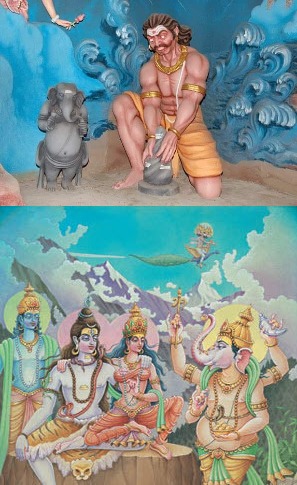– Ganesha as Trickster Series ( Part 2 )
Marie-Louise von Franz , a Jungian psychologist known for her interpretation of fairy tales and myths , saw the trickster archetype , as an inherently disruptive force , one who challenged established norms and structures ,
and who better to illustrate that than Ganesha , who established himself as the first deity to be always worshipped , despite the presence of the older Gods like the Trimurtis before him.
Von Franz also saw the trickster figure as a source of liberation, through them and their exploits , we are taught to explore new perspectives and solutions , breaking free from rigid, habitual patterns of thinking.
In an infamous tale, Sage Narada brings a mango to Kailash offering it to Siva and Parvati , calling it the fruit of wisdom , the catch was only one being could take it. They offer it to their kids,
Skanda ( Muruga ) and Ganesha, and a test was set, whoever was to go around the Universe first, would earn the fruit of all wisdom.
Skanda, the ever ready warrior, bolted across creation in his speedy vahana, the peacock.
Ganesha, stout , bubbly and with a rat as a vahana could not hope to defeat Skanda in a direct manner. That’s when the craftiness and wisdom of him as a trickster figure shone through.
He asks Narada , what is the meaning of the world , and what is the meaning of Uma Maheshwara, for which Narada sheepishly replies they are the same ( inferring that without Uma Maheshwara there would be no creation ).
So Ganesha replies, wouldn’t that mean going around my parents , the ones who are the cause of all creation , be the same as going around the world , for which even the divine couple had to agree.
In that way , Ganesha’s craftiness defeats the valor of the Senapati of the Gods , Muruga.
Elswhere , Ravana gets the prized Atma-linga from Shiva, with instructions that he should never leave it on the ground. The devatas sensing the turmoil it would cause the world beseech Ganesha ,
who comes to Ravana as a young brahmin boy, offering to hold the Lingam until he finishes his puja by the river , with the condition that he will call out to Ravana 3 times when it is too heavy for him to carry, and if he didn’t come by then, he would put it on the ground.
That is how the Lingam in Gokarna was said to have come about, Ganesha using his trickery , ability to change his form , and verbal joust , to bring about greater good.
Sadhakas of Ganesha , will tell you, how this trickster and transformative nature of him touches you , often times , bringing into attention a much simpler solution to a problem that you had been wrecking yourself over needlessly.
In this Budha Sankashti Chathurti ( Budha too signifying intellect ) , may we pay our respects to the crafty and playful Gaja Nayaka.
– Maha Ganapataye Namaha


No responses yet